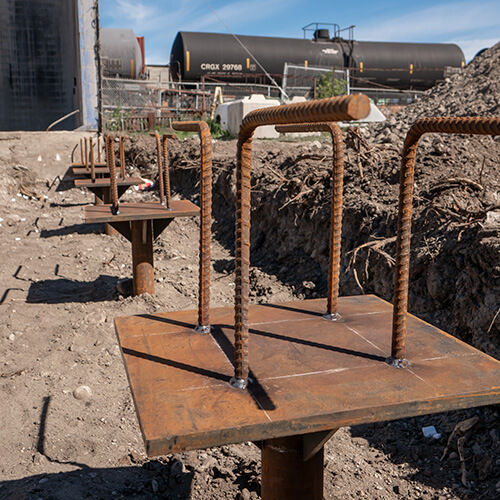Enhancing Grade Beam Support with Screw Piles
In the realm of structural building support, especially in regions like Red Deer, Alberta, where typically clay based soil conditions can be challenging, combining helical screw piles with concrete grade beams offers a robust solution. This method ensures stability and durability, proving ideal for deep ground support in both residential and commercial construction. Here we explore the benefits of this innovative pairing and why it represents a superior approach to traditional foundation methods, where concrete piles are used for the deep ground support.
Robust Stability and Load Distribution
Helical screw piles excel in providing deep ground anchorage. Contractors install these piles by screwing them into the ground until they reach stable soil layers, thus offering a reliable base for heavy structures. When combined with concrete grade beams, this system not only anchors a building effectively but also distributes the structural loads evenly across a broader area. Concrete grade beams span between piles, creating a network that supports the structure above and reduces the risk of differential settlement.

Quick Installation and Immediate Usability
One of the standout benefits of using helical screw piles and concrete grade beams is the speed of installation. Unlike traditional concrete foundations that require significant excavation and curing time, the installation of screw piles is rapid and causes minimal disruption to the site. Concrete grade beams can be formed and poured quickly once piles are in place, often allowing for the continuation of construction activities immediately after. This expedited process significantly reduces project timelines and associated labor costs.
Adaptability to Varying Soil Conditions
Red Deer features diverse soil types, some of which pose challenges for standard foundation methods. Screw piles adapt seamlessly to different soil conditions because installers can adjust their depth and placement to ensure optimal load-bearing capacity. The load bearing capacity of the soil is measured during the screw pile installation. This means that the load capacity of each helical pile can then be calculated, ensuring that each pile supports an appropriate amount of weight regardless of the soil characteristics at different depths.
Environmental Benefits
The combination of helical screw piles and concrete grade beams significantly reduces the environmental impact of construction. Screw piles install without extensive soil excavation and displacement, preserving the natural state of the land and minimizing the ecological footprint. Furthermore, because this method requires less concrete than traditional foundations, it also reduces the carbon emissions associated with concrete production and transport.
Cost Efficiency Over Time
Investing in helical screw piles for concrete grade beams can result in significant long-term savings. This system virtually eliminates the need for extensive ground preparation and large quantities of concrete, two factors that often drive up costs in traditional foundation methods. Additionally, the durability and reduced maintenance needs of this foundation solution mean fewer repair costs over the lifespan of the building.
Enhanced Resilience to Environmental Stresses
Buildings in Red Deer must withstand a range of environmental stresses, including heavy winds and potentially seismic activities. The integration of screw piles with concrete grade beams creates a foundation deeply anchored into the soil, enhancing the building’s resistance to such forces. This resilience is crucial for maintaining structural integrity and ensuring the safety of occupants.
Conclusion
For architects, engineers, and builders in Red Deer, Alberta, the combination of helical screw piles and concrete grade beams offers a superior foundation solution. This method provides robust support, adapts to diverse soil conditions, and enhances the structural integrity of buildings facing harsh environmental stresses. With faster installation times, reduced environmental impact, and cost efficiency, it’s clear why this innovative approach is becoming a preferred choice in modern construction.


